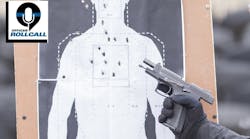Today's law enforcement training far exceeds the training from long ago. No longer do we dump spent cartridges in our palms and put them in our pockets just to keep the range clean. Innovative manufacturers have designed better equipment to allow us to conduct realistic scenario based training. More and more studies are conducted to find out what is working on the street and how to reinforce those tactics in training. Even with advancements in tactics, equipment, and greater emphasis on mental preparation, I am perplexed by the contradictions in the training we provide that can psychologically scar our students.
Now, I can hear everyone saying I don't do that. My training is realistic. I agree that most of your training probably is fairly realistic. If you're like me, you're doing the best you can with the limited training time and resources available. I am doing the same thing. The problem, as I see it, is our training is being undermined by our administrator's need and our own desire to simply get our officers through training and qualifications.
How many times a year does your agency qualify? Does your administration consider qualification a training evolution? Do your officers engage in realistic firearms training? When you conduct defensive tactics training, do you tell your students one thing, but teach them to do something different?
This is where the contradiction lies. We have to teach our officers to be able to save their lives in a street encounter, but our hands are tied. If the training is too realistic the officer may get hurt. That would mean workman compensation claims, overtime to cover the shift, and a mountain of paperwork. On the other hand, if training is too sterile, we are doing our officers a disservice and quite possibly instilling in them a false sense of security.
Training to Qualify
Most agencies have at least annual qualifications. Some have day and night qualifications. Some departments even qualify quarterly. The question is, why? I'm not against qualifying, but I think we should spend the limited time and resources we do have on training. Most qualification courses teach you to stand still and shoot at a paper target without inducing any type of stress. We have all heard about cases, from the old days, where officers were killed during a gun fight and empty shell casings were found in their pockets. This has been linked to their training (or more accurately range etiquette during qualification).
What about the mental software? The commands we give and actions we pace our students through to achieve our desired result? I know most officers have attended some advanced training that teaches them to shoot on the move, move to cover, and numerous other skills that can help them win their gunfight. Yet once this training is over, we stress the importance of going back to the range to qualify. Our officers will stand on the firing line and punch holes in a stationary cardboard target, while being told what to do every step of the way. We stress the importance of movement, use of cover, and decision-making under stress in a class, but typically only evaluate our officers on their ability to qualify in an unrealistic static environment. When is the last time an officer at your agency received remedial training or discipline for poor performance in an actual firearms training class as opposed to a qualification? We are spending a disproportionate amount of time and emphasis on qualifying as opposed to training.
The latest F.B.I. report shows that many officer involved shootings occur at close range (7 to 10 feet) and during low light situations. Then why do we continue to qualify during the day light hours from distances over 10 yards? Instead of using our ammunition and time qualifying, shouldn't we be training multiple scenarios in low light environments within 10 to 15 feet? We should be doing drills that increase speed, accuracy, reaction time, and judgment, not drawing a gun when given the command to FIRE. We should train, most of the time, for what our officers are most likely to encounter.
If your agency only has 200 rounds of ammo and 8 hours of training per officer annually, why spend 50 rounds and 2 hours qualifying? That's a quarter of your resources and you have not reduced your liability or trained your officers to win the encounter. The remaining time could be spent training to help your officers as long as you don't have to qualify again later in the year. Even if you had thousands of rounds available, and 40 hours to train, why reinforce behaviors that are not conducive to winning deadly force encounters?
Let's Start Practicing What We Preach
I understand that there may be state laws requiring you to qualify. In Florida for example we are required to qualify once every two years. I propose that we follow this requirement and only qualify every two years. We could then use the other time and resources to train.
Another problem during training is what the instructor says as well as what he does. I have attended numerous training sessions where the instructor stresses moving to cover when engaged in a gun fight. This is a great concept. The problem arises when you only practice moving to cover for a few minutes during a course, but stand still during the rest of the class or at qualifications. What is the student really going to do under stress?
Recently, I assisted with a training scenario for one of my neighboring agencies. The scenario consisted of an officer approaching a suspicious person. During the encounter, the suspect drew a firearm from his waistband as the officer interviewed him. The scenario was designed to assess the officer's response. After the training, I spoke to the agencies training coordinator about his officers' responses. He told me he was very disappointed because he teaches his people to step off line while drawing, but only about 10% of the officers did that when faced with the stress of the suspect pulling a gun. As we discussed why the officers did not perform as trained, it became obvious that he was not inducing enough stress during training to make it muscle memory in the scenario. I feel that the more stress you can induce in training, the deeper into the primal brain you can imprint the desired action you are training.
In part two, I will be discussing how the contradiction comes into defense tactics training. When conducting training where the students wear pads and engage in near real fights, how many times do we grab a student's gun but don’t allow them to respond with deadly force techniques?


